Driverless Cars: Ethical and Social Issues Impacting Society
VerifiedAdded on 2020/04/21
|6
|1342
|149
Essay
AI Summary
This essay analyzes the ethical and social issues that may arise with the introduction of driverless cars. It begins by defining driverless cars and highlighting their potential benefits, such as reduced accidents and improved traffic flow. The paper then delves into the ethical challenges, including the 'trolley problem' and how AI should make decisions in accident scenarios. It addresses the potential job losses for professional drivers and the need for societal adjustments. Furthermore, the essay discusses technological concerns like data security, cybersecurity, and the limitations of AI in handling unexpected situations. The author emphasizes the importance of considering both the costs and benefits of this technological transition, and the need for mitigation strategies to address the ethical and social challenges. In conclusion, the paper suggests that while driverless cars offer advantages, careful consideration of ethical and social issues is crucial before their widespread adoption. The essay also references several sources to support the arguments made throughout the paper.
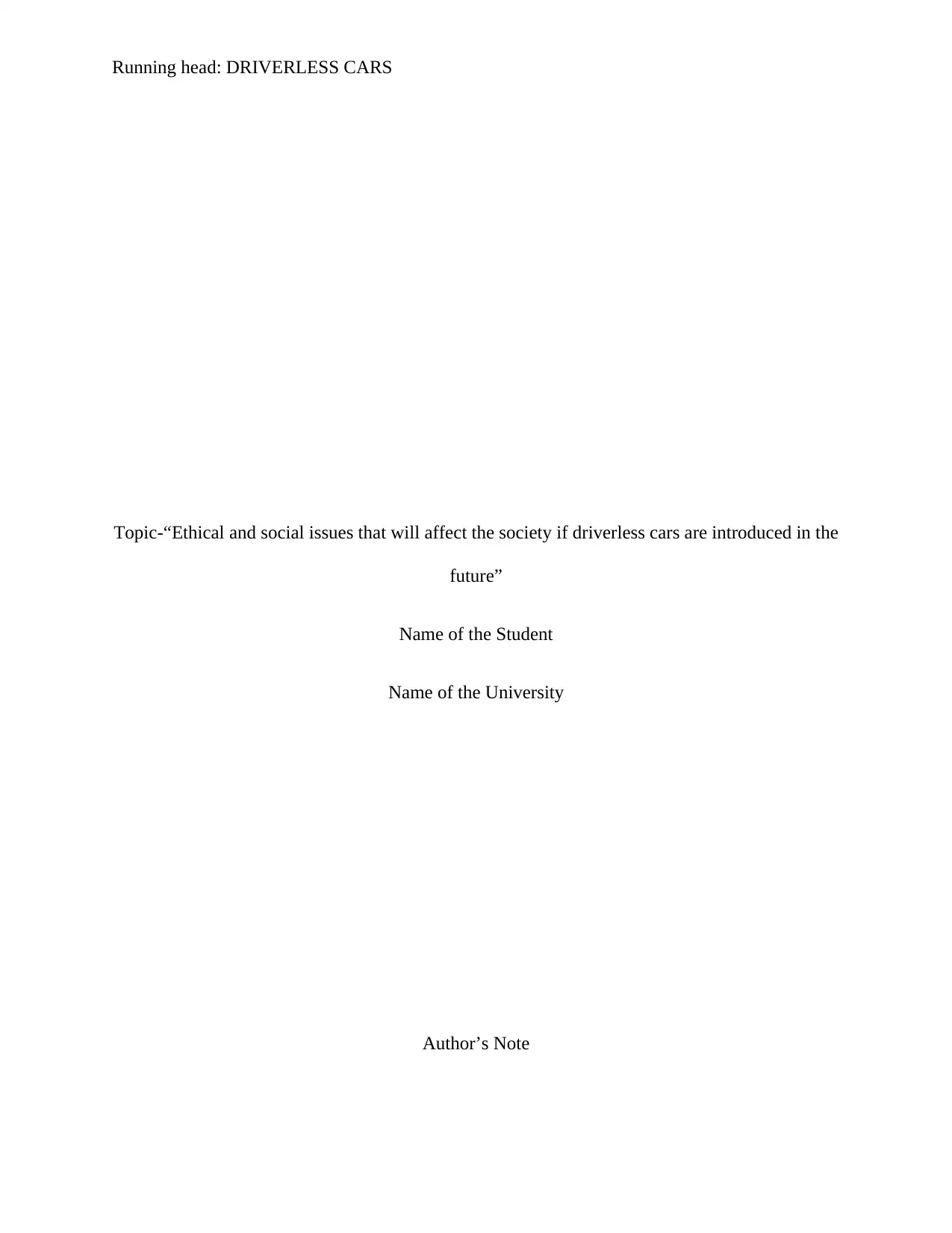
Running head: DRIVERLESS CARS
Topic-“Ethical and social issues that will affect the society if driverless cars are introduced in the
future”
Name of the Student
Name of the University
Author’s Note
Topic-“Ethical and social issues that will affect the society if driverless cars are introduced in the
future”
Name of the Student
Name of the University
Author’s Note
Paraphrase This Document
Need a fresh take? Get an instant paraphrase of this document with our AI Paraphraser
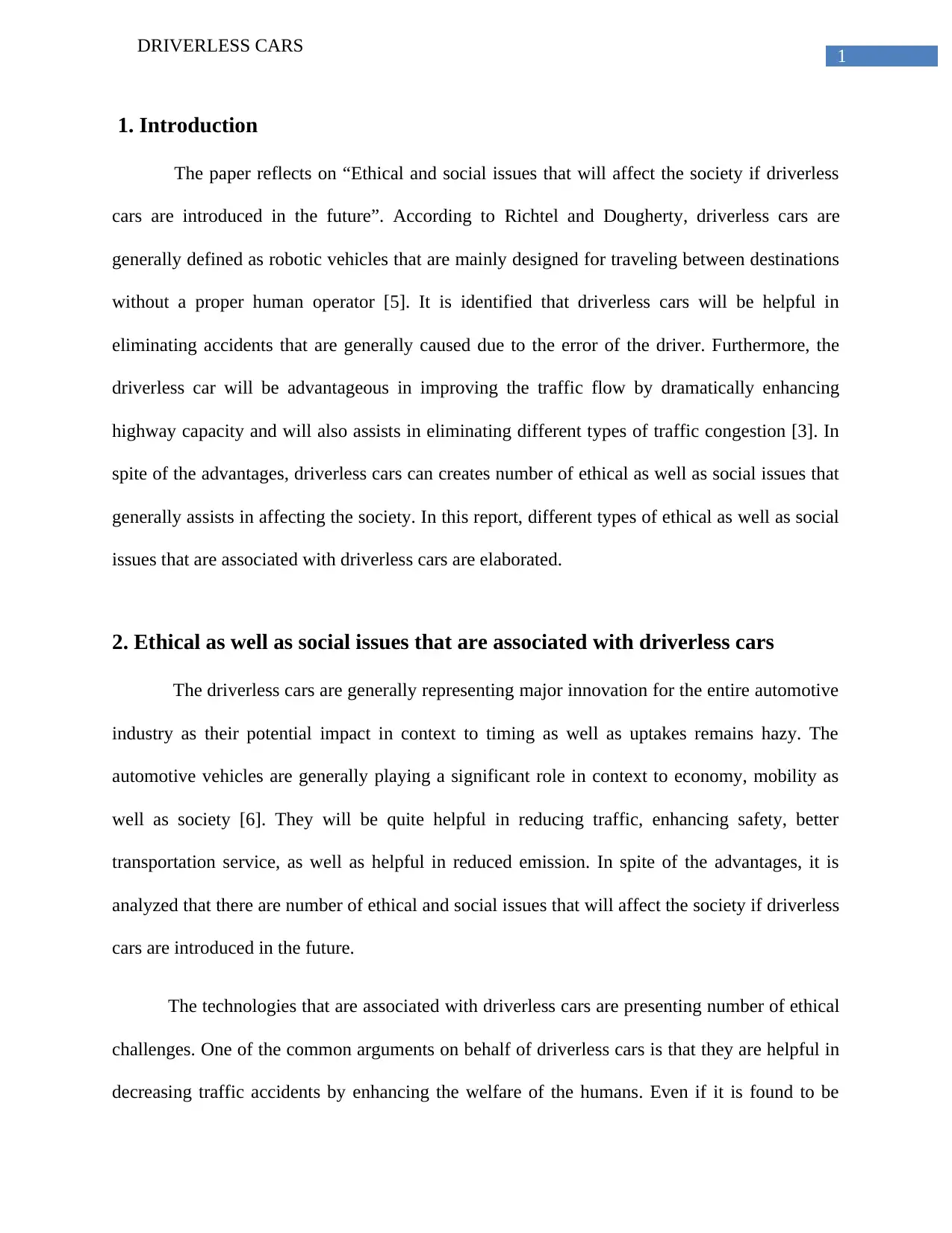
1
DRIVERLESS CARS
1. Introduction
The paper reflects on “Ethical and social issues that will affect the society if driverless
cars are introduced in the future”. According to Richtel and Dougherty, driverless cars are
generally defined as robotic vehicles that are mainly designed for traveling between destinations
without a proper human operator [5]. It is identified that driverless cars will be helpful in
eliminating accidents that are generally caused due to the error of the driver. Furthermore, the
driverless car will be advantageous in improving the traffic flow by dramatically enhancing
highway capacity and will also assists in eliminating different types of traffic congestion [3]. In
spite of the advantages, driverless cars can creates number of ethical as well as social issues that
generally assists in affecting the society. In this report, different types of ethical as well as social
issues that are associated with driverless cars are elaborated.
2. Ethical as well as social issues that are associated with driverless cars
The driverless cars are generally representing major innovation for the entire automotive
industry as their potential impact in context to timing as well as uptakes remains hazy. The
automotive vehicles are generally playing a significant role in context to economy, mobility as
well as society [6]. They will be quite helpful in reducing traffic, enhancing safety, better
transportation service, as well as helpful in reduced emission. In spite of the advantages, it is
analyzed that there are number of ethical and social issues that will affect the society if driverless
cars are introduced in the future.
The technologies that are associated with driverless cars are presenting number of ethical
challenges. One of the common arguments on behalf of driverless cars is that they are helpful in
decreasing traffic accidents by enhancing the welfare of the humans. Even if it is found to be
DRIVERLESS CARS
1. Introduction
The paper reflects on “Ethical and social issues that will affect the society if driverless
cars are introduced in the future”. According to Richtel and Dougherty, driverless cars are
generally defined as robotic vehicles that are mainly designed for traveling between destinations
without a proper human operator [5]. It is identified that driverless cars will be helpful in
eliminating accidents that are generally caused due to the error of the driver. Furthermore, the
driverless car will be advantageous in improving the traffic flow by dramatically enhancing
highway capacity and will also assists in eliminating different types of traffic congestion [3]. In
spite of the advantages, driverless cars can creates number of ethical as well as social issues that
generally assists in affecting the society. In this report, different types of ethical as well as social
issues that are associated with driverless cars are elaborated.
2. Ethical as well as social issues that are associated with driverless cars
The driverless cars are generally representing major innovation for the entire automotive
industry as their potential impact in context to timing as well as uptakes remains hazy. The
automotive vehicles are generally playing a significant role in context to economy, mobility as
well as society [6]. They will be quite helpful in reducing traffic, enhancing safety, better
transportation service, as well as helpful in reduced emission. In spite of the advantages, it is
analyzed that there are number of ethical and social issues that will affect the society if driverless
cars are introduced in the future.
The technologies that are associated with driverless cars are presenting number of ethical
challenges. One of the common arguments on behalf of driverless cars is that they are helpful in
decreasing traffic accidents by enhancing the welfare of the humans. Even if it is found to be
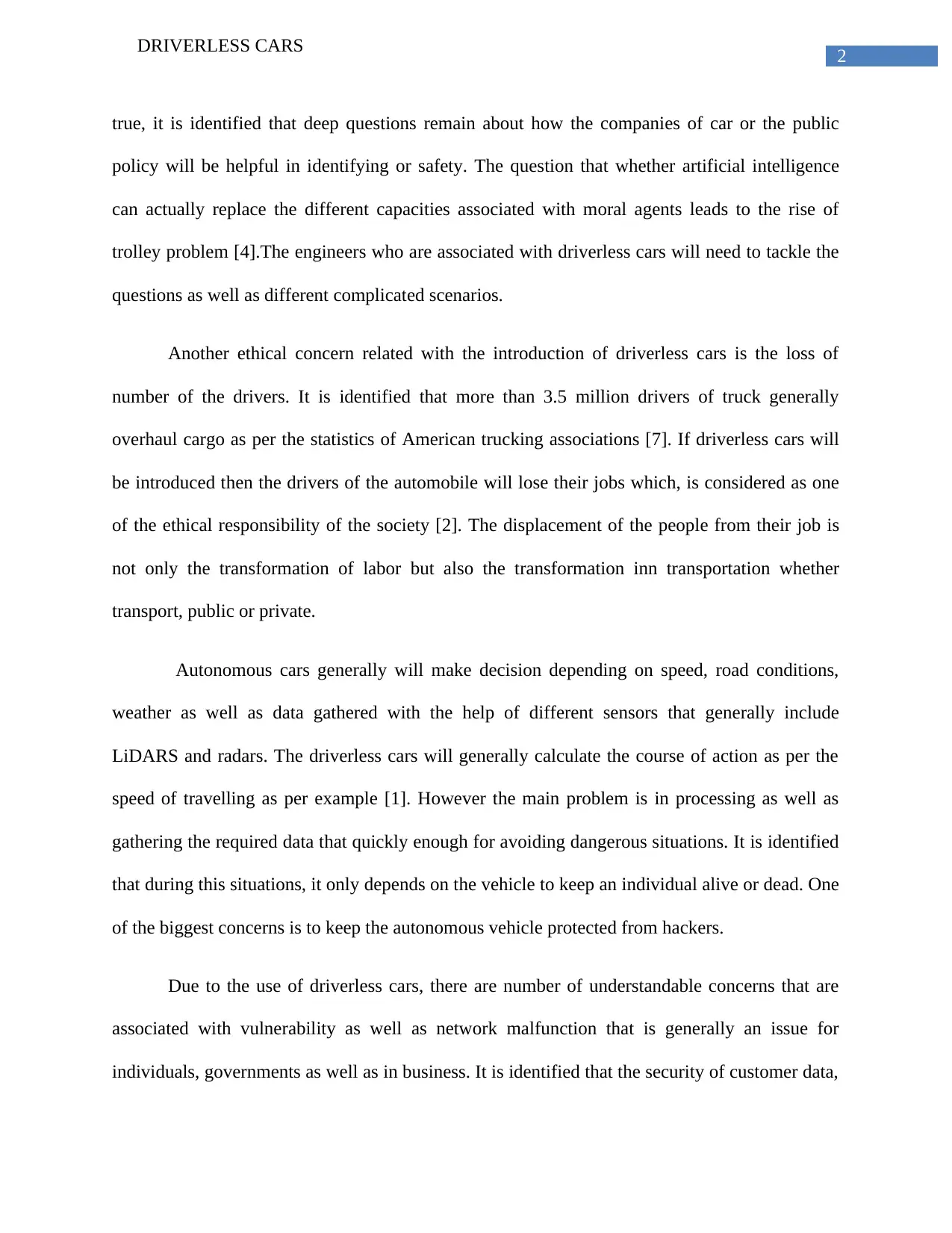
2
DRIVERLESS CARS
true, it is identified that deep questions remain about how the companies of car or the public
policy will be helpful in identifying or safety. The question that whether artificial intelligence
can actually replace the different capacities associated with moral agents leads to the rise of
trolley problem [4].The engineers who are associated with driverless cars will need to tackle the
questions as well as different complicated scenarios.
Another ethical concern related with the introduction of driverless cars is the loss of
number of the drivers. It is identified that more than 3.5 million drivers of truck generally
overhaul cargo as per the statistics of American trucking associations [7]. If driverless cars will
be introduced then the drivers of the automobile will lose their jobs which, is considered as one
of the ethical responsibility of the society [2]. The displacement of the people from their job is
not only the transformation of labor but also the transformation inn transportation whether
transport, public or private.
Autonomous cars generally will make decision depending on speed, road conditions,
weather as well as data gathered with the help of different sensors that generally include
LiDARS and radars. The driverless cars will generally calculate the course of action as per the
speed of travelling as per example [1]. However the main problem is in processing as well as
gathering the required data that quickly enough for avoiding dangerous situations. It is identified
that during this situations, it only depends on the vehicle to keep an individual alive or dead. One
of the biggest concerns is to keep the autonomous vehicle protected from hackers.
Due to the use of driverless cars, there are number of understandable concerns that are
associated with vulnerability as well as network malfunction that is generally an issue for
individuals, governments as well as in business. It is identified that the security of customer data,
DRIVERLESS CARS
true, it is identified that deep questions remain about how the companies of car or the public
policy will be helpful in identifying or safety. The question that whether artificial intelligence
can actually replace the different capacities associated with moral agents leads to the rise of
trolley problem [4].The engineers who are associated with driverless cars will need to tackle the
questions as well as different complicated scenarios.
Another ethical concern related with the introduction of driverless cars is the loss of
number of the drivers. It is identified that more than 3.5 million drivers of truck generally
overhaul cargo as per the statistics of American trucking associations [7]. If driverless cars will
be introduced then the drivers of the automobile will lose their jobs which, is considered as one
of the ethical responsibility of the society [2]. The displacement of the people from their job is
not only the transformation of labor but also the transformation inn transportation whether
transport, public or private.
Autonomous cars generally will make decision depending on speed, road conditions,
weather as well as data gathered with the help of different sensors that generally include
LiDARS and radars. The driverless cars will generally calculate the course of action as per the
speed of travelling as per example [1]. However the main problem is in processing as well as
gathering the required data that quickly enough for avoiding dangerous situations. It is identified
that during this situations, it only depends on the vehicle to keep an individual alive or dead. One
of the biggest concerns is to keep the autonomous vehicle protected from hackers.
Due to the use of driverless cars, there are number of understandable concerns that are
associated with vulnerability as well as network malfunction that is generally an issue for
individuals, governments as well as in business. It is identified that the security of customer data,
⊘ This is a preview!⊘
Do you want full access?
Subscribe today to unlock all pages.

Trusted by 1+ million students worldwide
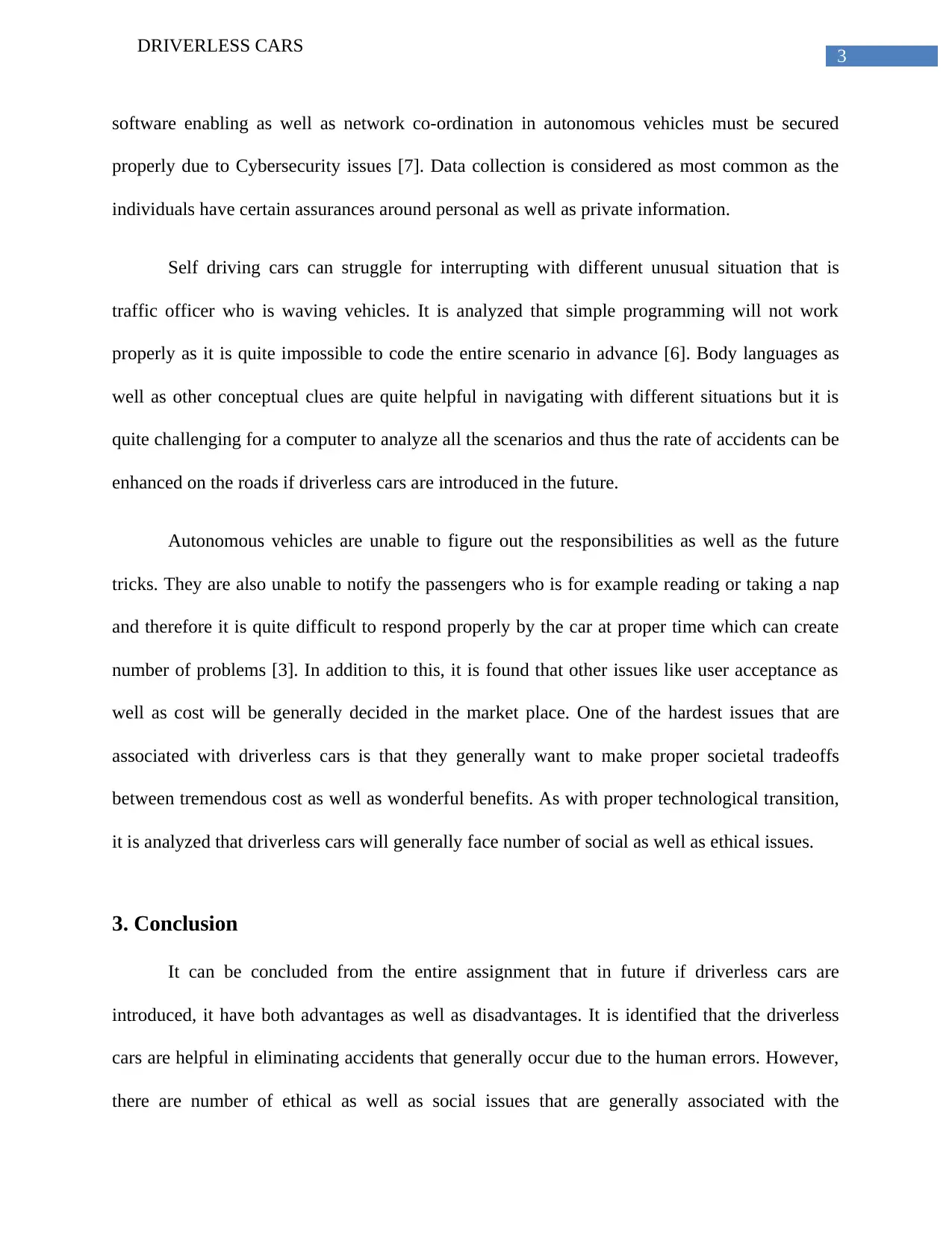
3
DRIVERLESS CARS
software enabling as well as network co-ordination in autonomous vehicles must be secured
properly due to Cybersecurity issues [7]. Data collection is considered as most common as the
individuals have certain assurances around personal as well as private information.
Self driving cars can struggle for interrupting with different unusual situation that is
traffic officer who is waving vehicles. It is analyzed that simple programming will not work
properly as it is quite impossible to code the entire scenario in advance [6]. Body languages as
well as other conceptual clues are quite helpful in navigating with different situations but it is
quite challenging for a computer to analyze all the scenarios and thus the rate of accidents can be
enhanced on the roads if driverless cars are introduced in the future.
Autonomous vehicles are unable to figure out the responsibilities as well as the future
tricks. They are also unable to notify the passengers who is for example reading or taking a nap
and therefore it is quite difficult to respond properly by the car at proper time which can create
number of problems [3]. In addition to this, it is found that other issues like user acceptance as
well as cost will be generally decided in the market place. One of the hardest issues that are
associated with driverless cars is that they generally want to make proper societal tradeoffs
between tremendous cost as well as wonderful benefits. As with proper technological transition,
it is analyzed that driverless cars will generally face number of social as well as ethical issues.
3. Conclusion
It can be concluded from the entire assignment that in future if driverless cars are
introduced, it have both advantages as well as disadvantages. It is identified that the driverless
cars are helpful in eliminating accidents that generally occur due to the human errors. However,
there are number of ethical as well as social issues that are generally associated with the
DRIVERLESS CARS
software enabling as well as network co-ordination in autonomous vehicles must be secured
properly due to Cybersecurity issues [7]. Data collection is considered as most common as the
individuals have certain assurances around personal as well as private information.
Self driving cars can struggle for interrupting with different unusual situation that is
traffic officer who is waving vehicles. It is analyzed that simple programming will not work
properly as it is quite impossible to code the entire scenario in advance [6]. Body languages as
well as other conceptual clues are quite helpful in navigating with different situations but it is
quite challenging for a computer to analyze all the scenarios and thus the rate of accidents can be
enhanced on the roads if driverless cars are introduced in the future.
Autonomous vehicles are unable to figure out the responsibilities as well as the future
tricks. They are also unable to notify the passengers who is for example reading or taking a nap
and therefore it is quite difficult to respond properly by the car at proper time which can create
number of problems [3]. In addition to this, it is found that other issues like user acceptance as
well as cost will be generally decided in the market place. One of the hardest issues that are
associated with driverless cars is that they generally want to make proper societal tradeoffs
between tremendous cost as well as wonderful benefits. As with proper technological transition,
it is analyzed that driverless cars will generally face number of social as well as ethical issues.
3. Conclusion
It can be concluded from the entire assignment that in future if driverless cars are
introduced, it have both advantages as well as disadvantages. It is identified that the driverless
cars are helpful in eliminating accidents that generally occur due to the human errors. However,
there are number of ethical as well as social issues that are generally associated with the
Paraphrase This Document
Need a fresh take? Get an instant paraphrase of this document with our AI Paraphraser

4
DRIVERLESS CARS
introduction of driverless cars. Due to the ethical as well as social issues, number of problem can
arise that include loss of personal data, increased road accidents as well as malfunctioning of
network. Therefore, it is quite important to think about the mitigation plan for the social as well
as ethical challenges which will be occurred before the introduction of the driverless cars.
DRIVERLESS CARS
introduction of driverless cars. Due to the ethical as well as social issues, number of problem can
arise that include loss of personal data, increased road accidents as well as malfunctioning of
network. Therefore, it is quite important to think about the mitigation plan for the social as well
as ethical challenges which will be occurred before the introduction of the driverless cars.
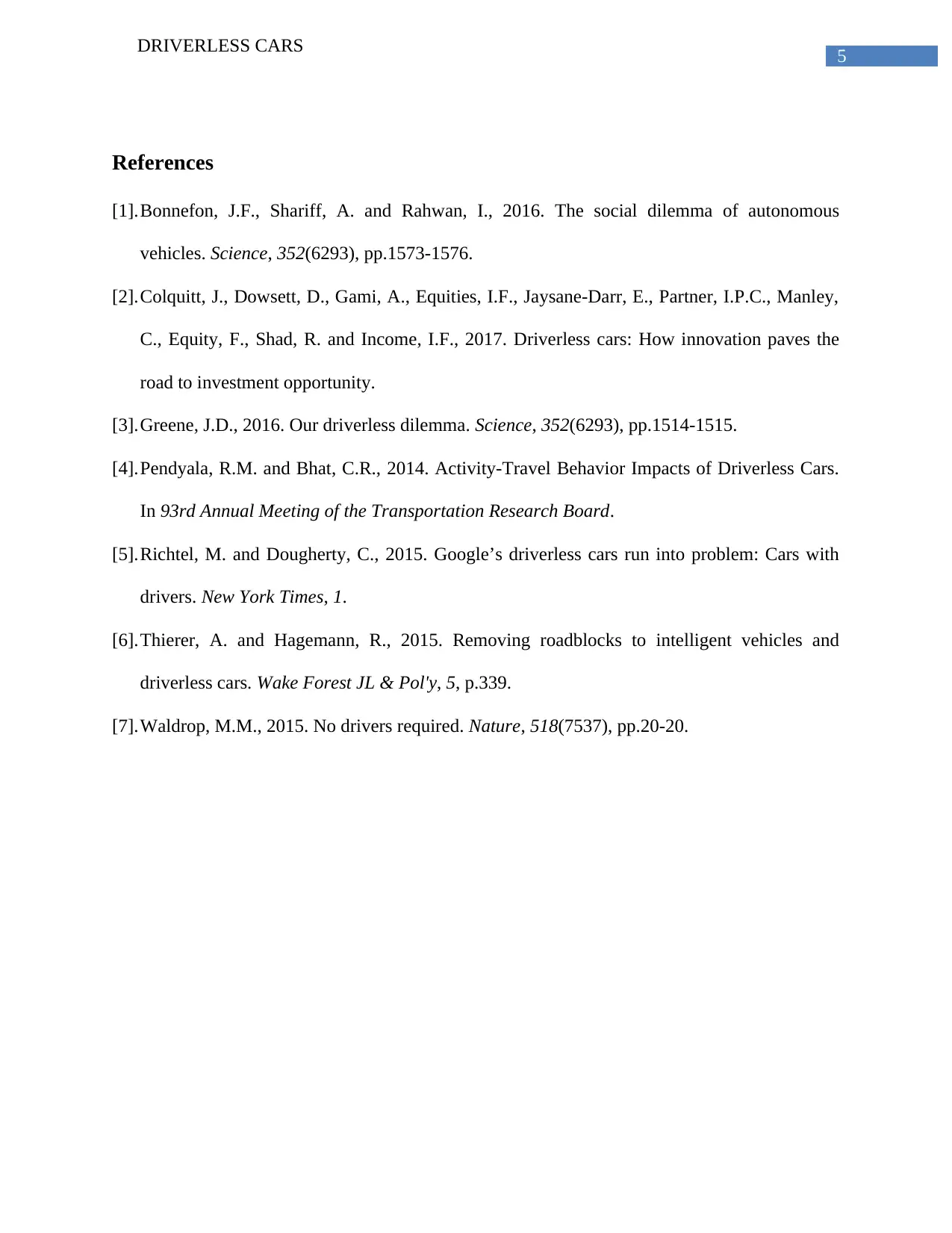
5
DRIVERLESS CARS
References
[1].Bonnefon, J.F., Shariff, A. and Rahwan, I., 2016. The social dilemma of autonomous
vehicles. Science, 352(6293), pp.1573-1576.
[2].Colquitt, J., Dowsett, D., Gami, A., Equities, I.F., Jaysane-Darr, E., Partner, I.P.C., Manley,
C., Equity, F., Shad, R. and Income, I.F., 2017. Driverless cars: How innovation paves the
road to investment opportunity.
[3].Greene, J.D., 2016. Our driverless dilemma. Science, 352(6293), pp.1514-1515.
[4].Pendyala, R.M. and Bhat, C.R., 2014. Activity-Travel Behavior Impacts of Driverless Cars.
In 93rd Annual Meeting of the Transportation Research Board.
[5].Richtel, M. and Dougherty, C., 2015. Google’s driverless cars run into problem: Cars with
drivers. New York Times, 1.
[6].Thierer, A. and Hagemann, R., 2015. Removing roadblocks to intelligent vehicles and
driverless cars. Wake Forest JL & Pol'y, 5, p.339.
[7].Waldrop, M.M., 2015. No drivers required. Nature, 518(7537), pp.20-20.
DRIVERLESS CARS
References
[1].Bonnefon, J.F., Shariff, A. and Rahwan, I., 2016. The social dilemma of autonomous
vehicles. Science, 352(6293), pp.1573-1576.
[2].Colquitt, J., Dowsett, D., Gami, A., Equities, I.F., Jaysane-Darr, E., Partner, I.P.C., Manley,
C., Equity, F., Shad, R. and Income, I.F., 2017. Driverless cars: How innovation paves the
road to investment opportunity.
[3].Greene, J.D., 2016. Our driverless dilemma. Science, 352(6293), pp.1514-1515.
[4].Pendyala, R.M. and Bhat, C.R., 2014. Activity-Travel Behavior Impacts of Driverless Cars.
In 93rd Annual Meeting of the Transportation Research Board.
[5].Richtel, M. and Dougherty, C., 2015. Google’s driverless cars run into problem: Cars with
drivers. New York Times, 1.
[6].Thierer, A. and Hagemann, R., 2015. Removing roadblocks to intelligent vehicles and
driverless cars. Wake Forest JL & Pol'y, 5, p.339.
[7].Waldrop, M.M., 2015. No drivers required. Nature, 518(7537), pp.20-20.
⊘ This is a preview!⊘
Do you want full access?
Subscribe today to unlock all pages.

Trusted by 1+ million students worldwide
1 out of 6
Related Documents
Your All-in-One AI-Powered Toolkit for Academic Success.
+13062052269
info@desklib.com
Available 24*7 on WhatsApp / Email
![[object Object]](/_next/static/media/star-bottom.7253800d.svg)
Unlock your academic potential
Copyright © 2020–2025 A2Z Services. All Rights Reserved. Developed and managed by ZUCOL.





